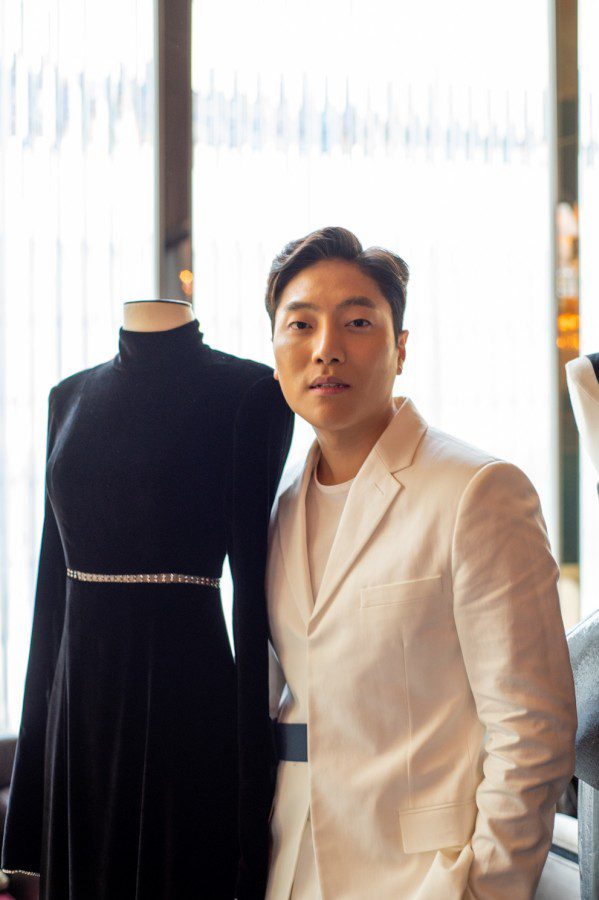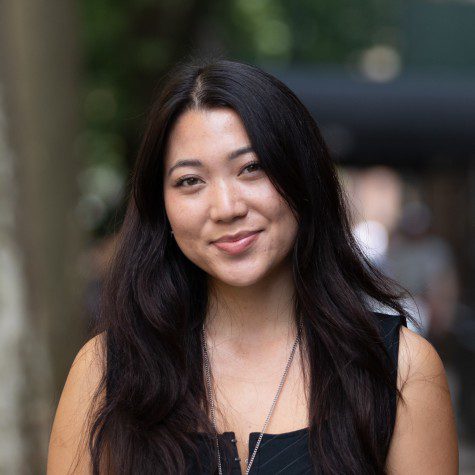Q&A: Designer Andrew Kwon on fashion and the internet
Evening and bridal wear designer Andrew Kwon spoke to WSN about his design process, his time at the Parsons School of Design and the influx of influencers in fashion.
Andrew Kwon showcases his Spring/Summer 2023 collection. (Manasa Gudavalli for WSN)
November 18, 2022
Andrew Kwon oozes intimacy. The Korean American designer recently launched his newest bridal collection, Rarefied, which was held in a private suite in the Peninsula Hotel on Fifth Avenue. Rarefied is his third line of bridalwear, and the fourth collection Kwon has launched since his first in 2021.
Far from the typical entryway into a life of cozy domesticity, his latest collection carries an intentional fluidity that feels modern and keeps with the opulence that the Parsons School of Design alum has brought to the world of bridalwear. A bride can choose to marry in attire ranging from a delicately layered tulle cupcake dress to a simple diaphanous silk to a glittering ensemble of exposed corsetry.
In an interview with WSN, Kwon spoke more about his personal background, discussed the impact of the internet in fashion, and explained exactly how he embodies the element of intimacy that is not just between bride and partner but between the bride and the dress.
This interview has been edited for length and clarity.
WSN: You launched your brand in the middle of the pandemic, on Instagram, before it was picked up by outlets such as The New York Times, and then retailers like Bergdorf and Neiman Marcus. Can you talk a little bit about how you’ve experienced growth as a brand in the digital space?
Andrew Kwon: I really took on Instagram. It was my senior year when I took my personal Instagram and I got rid of all my photos, and I started really only posting a lot of what my collections were and what my thesis was. I knew that I was going to use that same Instagram instead of creating a whole new one, because my closest supporters were my friends and my family. I didn’t want people to follow two different accounts because my brand and my story are both really personal to me.
My stories then started to transition into my day-to-day life, along with all the preparation that went into my official launch. It didn’t matter if I was going to a meeting with editors, or if I was going to one of my friend’s favorite restaurants, I’d post all of it. It’s interesting because I think with fashion designers, it’s a unique situation because there are some that are very, very private. And I’ve had a lot of people along the way say, “Why aren’t you a little bit more mysterious?” I’ve built my whole life on being honest with myself and being honest with people around me. Yes, I want people to see the collection and think the pieces are beautiful, but I also want them to understand that there’s a special memory that is built into each collection and a story that I hold personal to me.
WSN: What does a typical day in the studio look like for you?
Kwon: I always wake up right around 7 a.m. I don’t really need an alarm these days. The first thing I do is drink a whole cup of cold water, and then I’ll have hot green tea. It’s almost this ritual for me to really get into that calm headspace. And then, I shower and do my skincare, and then go and sit down at my table and turn my music on on my TV. I love cinematic music, and I’ll listen to that while I open emails and look over everything.
After that my day is always different. One day I’ll have nonstop fittings with potential or current clients, and the next day, it could be emails back and forth from reaching out to editors or stylists or producers, and then all of a sudden I’ll have a day of doing four or five hours of accounting and QuickBooks. I still do all of my own accounting.
It changes when going through preparation for a collection. There’s about a week and a half of really strong focus, sketching, and then another maybe five days or so of going through all the sketches that I’ve done and seeing what really feels fit for the next collection. And then it could be another two weeks of fabric selections, and finally around a month and a half of muslin fittings. Muslin is the fabric that you’re using for the prototype.
WSN: How has your background — Korean American heritage, living in Colorado, and then going to school at Parsons in New York — influenced your career?
Kwon: I grew up in a town called Colorado Springs, and I was one of the very few Asians there. I could really only understand little bits of Korean, and I think that was because my mom always said that she didn’t want any issues with my language in school and worried that there was going to be an issue with me speaking Korean all the time at home, and then going to school and speaking English.
We ended up living in California in middle school, and we moved to a town called Palos Verdes. It is a beautiful area, but it really was a shock moving to a town like that where kids had so so much. Not just so much in ways where they had the nicest cars, or they had the most beautiful homes, but in that they had so much knowledge of a second language like Korean or Chinese or Japanese. It was dynamic. I think it made me question my cultural identity for the first time because I had no knowledge of Korean. I could try to understand it, but I couldn’t respond, or read or write.
It was once I got to Parsons when I started becoming friends with a lot of international students, and a lot of Korean students would only speak to me in Korean. I think that’s where I started picking it up more, and then I started meeting my friends of friends who would visit Korea that I wanted to stay connected with, and finally I started learning Korean, learning to read and write from YouTube. Now I can definitely say that I can read and write Korean fluently.
I think the red carpet sort of plays along with me wanting to be a part of the conversation, not in the way of where I would be walking the red carpet, or acting, or singing or anything of the sort. I’d want to dress the types of Sandra Oh, Lucy Liu — we all know the names — and really be that Asian American voice and show that these types of dreams are possible, even from a boy growing up in a small town in a state like Colorado.
WSN: Your presentations have been quite intimate, with limited attendees. What are your thoughts on the influx of influencers in events like New York Fashion Week that have traditionally only been held for those in the fashion industry?
Kwon: I respect what everyone is trying to do because everyone has a dream and everyone has a goal. But, especially in Bridal Fashion Week, I wanted to really invite people that were friends of the brand — family and editors and specific photographers that came about serendipitously, or through Instagram or connecting with them at my last show. It works for some brands to probably invite hundreds of micro influencers to really get that brand name out there. But it was important to me to just invite people that I was familiar with, and maybe through word of mouth from others, so they can bring someone they know as well. My favorite thing to do is to meet new people, and I think I can trust that the people I know can help me expand, and it’s just so fun to listen to other people’s stories. I think learning about people helps you grow in life.
WSN: What does your design process look like, and what advice would you give to any aspiring designers to stay innovative?
Kwon: I work based on my intuition a lot. When I was first launching, I had no idea what I was going into, with the marketplace and what the clients’ wants and needs were. I think it was really learning and listening to what women loved that started steering the direction for the next collection, even against what some of the editors were saying about the pieces.
Within the 11 pieces in the second collection, I took some from the first collection and inspired them into a different silhouette that was similar to the rest of the second collection. Then I finally debuted this evening wear collection where I looked at what pieces had the most attention, and figured out where they could transition into evening wear. But you can’t do that with everything from the collection, because I think it loses a sort of specialness. Different fabrics, different colors, different even by just cutting some of the layers and tulle layer. It has to feel like it’s right for me.
I would tell emerging fashion designers to have a clear vision of who you are and what your brand is. I think it’s always important to listen to yourself, and never take no for an answer. I’ve had a lot of professors at Parsons ask me, “Are you sure you want to be a designer?” or, “Oh, are you sure you want to be an evening wear designer?” or “Are you sure you want to do dresses? I don’t get it. It’s so oversaturated,” and this and that. I stuck with what I wanted to do with some incredible support from professors that believed in me, and I think knowing that other people believed in me started to make me believe in myself even more.
Everyone says something because they have their own experiences and it’s all about learning. I think I’ve learned a lot from some of the critiques or some of that advice, and I take everything into consideration. For me, I might listen to every single part but I almost bolted in my brain to hear them out while putting my own thoughts into it as well. Stay true to yourself, and always, always dream bigger.
Contact Olivia Liu at [email protected].




























































































































































